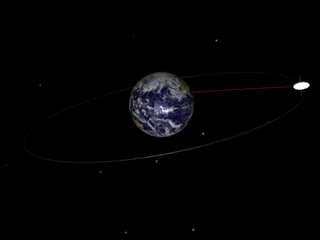
Geosynchronous orbit (GSO) - the orbit of a satellite orbiting the Earth , on which the period of revolution is equal to the stellar period of the Earth's rotation - 23 h 56 min 4.1 s .
A special case is the geostationary orbit - a circular orbit lying in the plane of the earth's equator , for which the satellite in the sky (for the earth observer) is practically stationary. The geostationary orbit has a radius of 42,164 km with a center coinciding with the center of the Earth, which corresponds to an altitude of 35,786 km .
If the orbit has a non-zero inclination and zero eccentricity, then when observed from the Earth, the satellite during the day describes the eight in the sky. If both the inclination and the eccentricity are nonzero, then the eight can degenerate into an ellipse (Canyon series satellites) or into a line segment lying in the equatorial plane (with nonzero eccentricity and zero inclination, for example such an orbit in DM-SL upper stages ).
The first communications satellite in geosynchronous orbit was Syncom-2 , launched by the United States on July 26, 1963. Sometimes the conclusion to the geosynchronous orbit is caused by the fact that the launch vehicle that launched the satellite does not have enough energy to put this spacecraft directly into the geostationary orbit.
There are catalogs of objects in geosynchronous orbits. [one]
Orbit Characteristics
For all geosynchronous orbits (both circular and elliptical), the major semiaxis is 42 164 km [2] For any orbital period P, the size of the major semiaxis a is calculated by the formula
Where - geocentric gravitational constant , Equal to 398 600,4418 km³ / s² , the product of the mass of the Earth by the gravitational constant [3] .
In the particular case of a geostationary orbit, the satellite’s ground path is the only point on the equator. In the general case of geosynchronous orbits with non-zero inclination or eccentricity, the track is a more or less distorted eight.
Geostationary Orbit
Geostationary orbit (GEO) is a circular geosynchronous orbit in the plane of the Earth's equator with a radius of about 42,164 km (measured from the center of the Earth). A satellite in such an orbit is located at an altitude of about 35,786 km from mean sea level. A similar orbit is sometimes also called Clark's orbit in honor of Arthur Clark . These orbits are convenient for telecommunication satellites.
An ideal geostationary orbit is practically unattainable, since the satellite is under it under the influence of several additional forces, for example, the solar wind , the pressure of electromagnetic radiation , attraction from the side of the moon and the sun; the influence of heterogeneity of the Earth's gravitational field. Satellites have to make various maneuvers in order to stay in geostationary orbit.
Tundra Orbit
The Tundra orbits are elliptical geosynchronous orbits, their typical eccentricity from 0.25 to 0.4. The inclination of such orbits is from 62.15 ° [4] to 63.4 °;
Such orbits are used, in particular, by the Sirius XM Radio company ( Sirius XM system of three spacecraft) and the Japanese navigation system QZSS .
See also
- Burial orbit
- Synchronous orbit
- Low reference orbit
- Geo-transitional orbit
Notes
- ↑ CLASSIFICATION OF GEOSYNCHRONOUS OBJECTS .
- ↑ Vallado, David A. Fundamentals of Astrodynamics and Applications. - Hawthorne, CA: Microcosm Press, 2007 .-- P. 31.
- ↑ Gravitational constant / V.K. Milyukov, M.U. Sagitov // Space Physics: Small Encyclopedia / Editorial: R. A. Sunyaev (Ch. Ed.) And others - 2nd ed. - M .: Soviet Encyclopedia , 1986. - S. 220—222. - 70,000 copies.
- ↑ Tipos de órbitas. Constelaciones de satélites . Universidad Politecnica de Madrid. Date of treatment February 5, 2011. Archived on May 31, 2012.
Links
- Geosynchronous Orbit ( inaccessible link) . Science @ NASA. Archived on April 29, 2005.
- Planetary Orbits . NASA Archived on February 5, 2012.
- Science Presse data on Geosynchronous Orbits (including historical data and launch statistics ) (inaccessible link) . Archived on November 4, 2004.
- Orbital mechanics . Rocket and Space Technology. Archived on February 5, 2012.